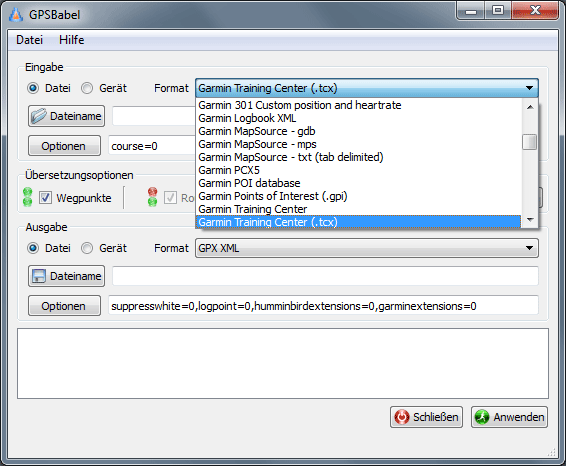

The first part just create a GPX file for every TXT file inside their same folder. "X:\GPSBabel\gpsbabel.exe" -t -i gpx %f% -x discard,hdop=10,vdop=20 -x duplicate,location -x simplify,crosstrack,error=0.001k -x nuketypes,waypoints -o gpx -F C:\FOLDER2\%DATE:~6,4%_%DATE:~3,2%_%DATE:~0,2%_LOG.gpx Rem // Prepare an empty file to begin with:įor /F "delims=" %%I in ('dir /B /A:D-L-H-S /O:N "?"') do (Ĭopy /B "metadata.txt" + "%%I\gpsdata.txt" "metadata.txt" > nulįor those that may need to convert using GPSBabel on several txt files with the same name inside different subfolders to get a GPX out of them, I was able to perform this with the following batch file: setlocal enabledelayedexpansionįOR /F "delims=" %%i IN ('DIR /S /B C:\FOLDER1\metadata.txt') DO "X:\GPSBabel\gpsbabel.exe" -t -i xcsv,style=C:\mystyle.style -f "%%i" -x discard,hdop=10,vdop=20 -x duplicate,location -x simplify,crosstrack,error=0.001k -o gpx -F "%%i".gpxįor /F "delims=" %%f IN ('DIR /S /B C:\FOLDER1\*.gpx') DO set f=!f! -f "%%f" Rem // Append the text file to the result file:Ĭopy /B "C:\FOLDER1\metadata.txt" + "%%~I\gpsdata.txt" "C:\FOLDER1\metadata.txt" > nulĪpproach using for /F and dir (sub-directories are sorted in alphabetic manner due to /O:N): rem // Change into target directory: Rem // Check whether the current sub-directory contains the text file: GPX points that contain time or almost any track data) this will be important to you.

If youre using data that has timestamps (e.g. In general, GPSBabels KML writer is relatively strong. Rem // Iterate over the immediate sub-directories:įor /D %%I in ("C:\FOLDER1\?") do ( Google Earth also uses GPSBabel internally for receiver communications and several file format imports and exports. What you need is for /D, or for /F together with dir in order to control sorting.Īpproach using for /D (sub-directories are iterated in the order as returned by the file system): rem // Prepare an empty file to begin with: You could wrap them up into a function call, but just using lapply will be more straight forward I think.Do not use for /R, neither do use for /F with dir /S, since you have got a flat directory structure. Using the for-loop results in x, temp, and visit.id hanging out afterwords. Using something from the *apply family has the benefit leaving a clean working space behind as well. Out <- lapply(files, function(x) readGPS(i = "gpx", f = x, type = "w"))Īnd out is now a list of 2, where each object is a ame with the name of the file that it was associated with previously. For our purposes, the Translation Options will have 'Waypoints' checked. Click on the 'File Name' button and navigate to the.

For the 'Input', select File and use the down-arrow at the right of the Format field to fiind 'Garmin Points of Interest (.gpi)'. Lapply(files, function(x) file.rename(from = x, to = gsub("\\s+", "_", x))) After installing GPSBabel, open the program. Replace with the character of your choice.

#Replace all space characters with a "_". For example, files <- dir(pattern = "\\.gpx") I find dealing with a list object easier than having lots of different objects floating around. Have you tried this on a fresh instance of R?įWIW, I would probably read all of these files into a single list object. Is that right? I assume the NA bit in the file names is due to how you are defining visit.id and my test file names not fitting into that paradigm. I have two objects names test1.gpx_NA_NA and test2.gpx_NA_NA with three observations of 28 variables. Hopefully at least one way has worked and I. Ken Coertze managed to convert them for me today anyway, but I have also done it the way you suggested.
GPSBABEL NV2 TO GPX CODE
NOTE: To run readGPS you will need the open source GPSBabel program installed and referenced in your PATH variable.Īfter installing GPSBabel and updating the PATH variable, your code snippet ran fine. Run it up on homeport, then click on the ADM file name (User Data) that you saved on the card, then got to 'file' - 'Export' and it will save the contents as a GPX file. I can read one file thus: library(maptools) I want to load them into R with different names and manipulate them.
GPSBABEL NV2 TO GPX FULL
Or move the bat file into that folder if you have set full path to the files. Most likely 'C:\Program Files (x86)\GPSBabel\gpsbabel' in double quotes to escape the blank in the path. gpx files (these contain GPX waypoint data from a Garmin eTrex). You might need to add the path to gpsbabel.exe if it is not already in the PATH variable.


 0 kommentar(er)
0 kommentar(er)
